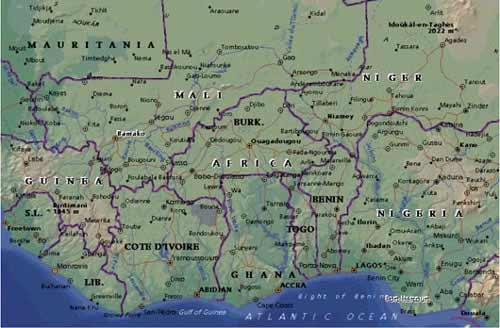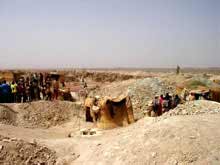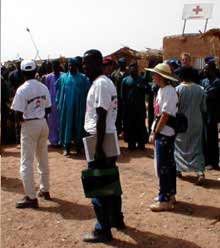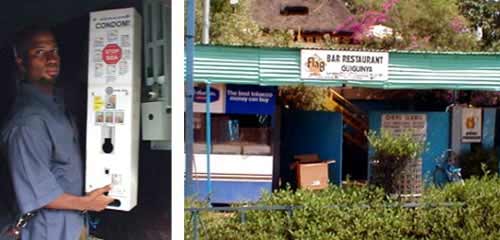|
|
|
|
Letter from Niger: The Niger River, AIDS, and Volunteer Marriage
By J. R. Bullington
Storks and rains
The annual rains, along with the migratory storks that always accompany them, arrived early this year promising relief from food shortages and threatened famine. Substantial expanses of greenery now mark the orange-brown landscape; dry ponds and riverbeds are filling; and the animals again have adequate forage and watering holes. Humans, however, must wait another month or two before the millet, now eight or ten inches high, is ready for harvest. And they must pray that the rains do not end prematurely, as they did last year, causing much of the crop to wither before it ripened.
Meanwhile, a substantial amount of food aid has arrived from several foreign donors, including the US. (CARE, Catholic Relief Services, Africare, and Helen Keller International are distributing USAID-provided food through food-for-work projects.) Soaring grain prices stabilized and then fell, and it appears that traditional coping strategies — selling off livestock, eating leaves and other "famine food," cutting consumption to one meal per day or less, moving to towns to find temporary work or handouts — will enable everyone except the weakest and most vulnerable to survive until the next harvest.
To survive until the next harvest: That's pretty much what life is all about for most Nigeriens.
The Strong Brown God
The Niger River, from which the country takes its name, was the last of the world's major rivers to be mapped by European explorers. The story of their search, which began at the end of the 18th Century and was not concluded until 1830, is chronicled in an excellent book called The Strong Brown God (a title taken from a poem by T. S. Eliot). It was written by Sanche de Gramont and published in 1976. I recommend it highly for anyone who is interested in learning more about this part of the world while at the same time being well entertained by a true adventure story, an epic of African exploration.
At 2600 miles, the Niger is the tenth longest river in the world. Its existence was known since the time of the ancient Greeks (it was mentioned by Herodotus), yet its course and destination remained a mystery for over 2000 years.
One reason why the puzzle was so difficult to solve is that the Niger is something of a geological freak among rivers. Its sources are in the hills of Guinea, only 150 miles from the Atlantic; but it flows backwards, away from the sea, toward the northeast and the Sahara Desert. Then, flowing along the desert's rim, past Timbuktu (Tombouctou) and Gao in Mali, it turns back to the southeast, through Niger and Nigeria, eventually to make its way back to the Atlantic through a vast, oil-rich delta in the Port Harcourt area.

Though the European search for the source of the Nile got much more attention, because of its connection with ancient Egypt and the Mediterranean, the Niger posed an equally interesting but opposite problem: Its source was known, yet no one had traced its course or discovered its mouth. Europeans who explored the West African coast thought that the multiple streams flowing through the Niger's huge delta were separate, unconnected rivers.
There were several barriers to European exploration of Africa's interior and the Niger's course. First and most obvious was the continent's vast expanse — it is three times the size of the continental US. Moreover, though its coast was charted, first by the Portuguese and then others, there were few good harbors or navigable rivers on which to develop bases. To the north, the Sahara was a formidable obstacle, both geographically and politically, as it was controlled by Arabs and other Muslims who were hostile to Christian Europeans. There was also the problem of diseases, particularly malaria, which earned West Africa the sobriquet of "the white man's grave." Until quinine began to be used to combat malaria in the mid-19th Century, few Europeans could survive there, so it was not economically attractive. And finally, Africans had little experience of commercial or other contacts with the outside world, and they were often hostile to those who managed to penetrate into the interior and reach them. Many explorers never returned.
Thus, until the middle of the 19th Century, the interior of Africa was blank on European maps.

|
| Ferry landing on the Niger River near Gotheye, northwest of Niamey. There are only two bridges over the river in Niger. One, the Kennedy Bridge in Niamey, was built by USAID in the 1960s. The other, where the river forms the border between Niger and Benin, is on the main highway connecting Niger with Cotonou and the West African coast. |
The first European to explore part of the Niger was Mungo Park, a Scottish doctor who was sent in 1795-96 by a private British group called the African Association. Park's widely read account of his harrowing adventures, and his finding that the Niger flows east (rather than west, as had been believed since Roman times), prompted several other expeditions. Park also returned to the Niger, in 1805, as the first African explorer to be sponsored by the British Government; but in floating down it to look for its mouth, he simply disappeared.
None of the other explorers who followed Mungo Park succeeded in finding the Niger's mouth until Richard and John Lander made that discovery in 1830. Together with the use of quinine to treat malaria, which began a few years later, this opened up the interior of West Africa for traders and missionaries, and eventually soldiers to protect them. By the end of the 19th Century, all the territory along the Niger was incorporated into the French and British colonial empires. What is now the country of Niger became part of French West Africa.
The AIDS pandemic
I wrote a few months ago about the AIDS pandemic, which is striking Africa with a force that makes it one of the worst disasters in the history of mankind, comparable to the Black Death that ravaged Europe in the Middle Ages. Of 30 million people infected by the HIV virus worldwide, two-thirds are in Africa. In seven African countries, a fifth of the adult population is infected. One out of five! And it's not only adults who are being struck down. According to a recent WHO report, some 300,000 African children died of AIDS in 2000, and 400,000 were newly infected by the virus. And experts predict that there will be 40 million AIDS orphans in Africa by 2010. Forty million! The numbers are simply staggering.
Niger is not one of the worst-affected African countries. Here, the HIV infection rate is "only" about 3-5% of the adult population. (This is just an informed guess, since no one has been willing or able to finance the sort of epidemiological study needed to determine the true rate.) But the problem is getting worse, and both the Government and foreign donors have given the highest priority to bringing it under control before it overwhelms the country.
Our Peace Corps Volunteers have been increasingly active in this struggle. Following are stories about two of their most recent projects.
Fighting AIDS in a gold rush camp
Until recently, Koma Bangou was a typically impoverished village of a few hundred people in the midst of a treeless, arid Sahelian plain some 170 kilometers northwest of Niamey. In 1989, Etruscan, a Canadian gold mining company, began exploration in the area and eventually found a substantial deposit estimated of gold. The ore is of low quality, however, and a 1997 feasibility study determined that its exploitation is not commercially viable at currently low gold prices. Consequently, Etruscan closed down operations, leaving its small camp behind.
For a time, the Government kept Army troops at the site to protect its interests and Etruscan's concession, but the troops were removed in 1999. This, together with Niger's extreme poverty and lack of other employment opportunities, led to a gold rush, as entrepreneurs began staking claims and digging small, artisanal mines. Although it is illegal in view of Etruscan's still-valid concession, the Government tolerates this activity, and Etruscan is apparently not trying to enforce its claim.

|

|
| Koma Bangou mines | Talking about AIDS |
Today, Koma Bangou is a teeming gold rush town of straw huts and small hills of mine tailings concentrated around hundreds of well-like mine shafts descending as much as 50 meters or more into the ground. Population estimates range up to 100,000, but somewhere around 40 - 50 thousand is probably a better guess. Most are Nigerien, but there are substantial contingents from Burkina Faso, Mali, Benin and Ghana, as well as a few from other West African countries.
About three-quarters of the people in Koma Bangou are young men who work in the various mining operations, all of which are done by hand. They are either single or have left their wives and families behind in their villages. The rest of the population services the miners: merchants of all kinds, bar owners, narcotics traffickers, and prostitutes. The latter are thought to number about 2000.
The mining process works like this: An entrepreneur with sufficient capital will stake a claim, essentially by squatting on it — no formalities seem to be involved. He will then hire laborers to dig a well-like shaft into the ground, which usually goes down 20 or 30 meters (but sometimes much deeper) to reach the ore body. Once the ore is found, miners are lowered by rope into the hole to chip out the ore, which is put into sacks and hauled to the surface. There, strong-armed young men using iron mortars and pestles pound the ore into powder. The powder is then taken to a sluice where the flakes of gold are washed out in a process that would be familiar to the people around Sutter's Mill in 1849. Buyers using balance scales and one-CFA coins that weigh a gram purchase the flakes. The buyers export these flakes to eventually become a tiny part of the global gold supply.
This artisanal mining is extremely difficult, dirty and dangerous work, especially for those who descend into the holes. Accidents are frequent, and safety and sanitary conditions are appalling by Western standards. Deaths occur almost daily.
Owners and workers split the revenues 50-50. There are many stories, and many more dreams, of owners who have gotten rich quickly and now work a dozen or more mines, live in Niamey villas, and drive Toyota Land Cruisers. For the workers, they at least eat regularly (which would be unlikely back home), and they have enough extra money to buy alcohol, narcotics (marijuana and amphetamines are said to be commonly used), and prostitutes.
Many of our Peace Corps Volunteers heard about Koma Bangou because the young men from their villages—especially those hardest hit by the current food shortages—have gone there to work. Some of the Volunteers living in the region visited the site and recognized it as a veritable petri dish for the HIV virus. No one knows the rate of infection, but with prostitutes coming from as far away as the West African coast it is likely to be high and growing. Of 50 prostitutes who asked to be tested thus far, according to one health worker at the site, 23 were HIV positive.
Moreover, as is commonly the case in Niger, most of the people at Koma Bangou are ignorant about AIDS, its consequences, how it is transmitted, and how it can be prevented. Government health services are minimal to nonexistent, and condoms are generally unknown and unavailable.
Since most of the young men at Koma Bangou will eventually return to wives and girlfriends in the villages they left, the potential for rapid, widespread transmission of HIV is clear.
Under the leadership of PCV Tiffany Martindale, who is stationed in nearby Gotheye, a group of Peace Corps Volunteers decided to conduct an eight-day AIDS education "blitz" at Koma Bangou April 28 - May 5. They mobilized 20 Volunteers and 22 AIDS workers from the Government's anti-AIDS program and from several non-governmental organizations, including CARE. Financial support came from the US Embassy as well as Peace Corps.

|
| Environmental concerns and the camp's sheer ugliness are among the least of the problems at Koma Bangou. Appalling safety and sanitary conditions cause frequent accidents and illness, and narcotics trafficking and prostitution are commonplace. A few get rich, and for others, it beats starving back home in the village. |
Logistics and working conditions were difficult. Koma Bangou is far from major roads and towns, and everything from food to firewood as well as the educational materials had to be brought in. Moreover, this is one of the hottest regions of Niger, and April and May are the two hottest months of the year, with temperatures soaring into the 120s during the day and remaining above 90 even at night.
Volunteers and educators were organized into seven multi-lingual teams, which went through the site for four hours every morning and two hours in the late afternoons. They gathered crowds, and used pictures and presentations in Hausa, Djerma, French and English to convey the anti-AIDS message. Condoms were demonstrated (with large plastic penises, which were a great hit) and distributed. There were also evening sessions with videos and a band. Prostitutes, bar owners and barbers were especially targeted.
In all, over 15,000 men and 1000 women heard the presentations.
Interest and receptivity to the message were very high; according to Tiffany higher than in any of the several other AIDS projects in which she has been involved. People asked questions and got involved.
Moreover, the event generated high-level Government awareness of and interest in the AIDS threat at Koma Bangou. US Ambassador Barbro Owens-Kirkpatrick visited the project and invited the Minister of Health and the Minister at the Presidency for AIDS Coordination to come along. This was the first visit to Koma Bangou for both.
We also mobilized the Nigerien press to accompany the Ambassador and the Ministers. This resulted in extensive local radio and TV coverage as well as stories (by their local stringers) on BBC's Hausa service and Radio France International.
Don's condom machines
One of the major problems in fighting the spread of AIDS in Niger is the limited availability of condoms. They are sold primarily in pharmacies, which means they aren't readily available when and where they are most needed. Moreover, cultural and religious taboos make it difficult for most Nigeriens to buy condoms in a public setting.
A creative Peace Corps Volunteer, Don Johnson, thought of a simple answer to this problem: condom vending machines, the sort that are ubiquitous in barroom and service station public bathrooms throughout the United States. If such machines could be placed in the bathrooms of Nigerien nightspots, Don reasoned, particularly those frequented by prostitutes, this would make condoms easily available for purchase in private, and in the very places where they are most needed to help curb the spread of HIV.
In Niger, however, solutions that may appear to be simple usually turn out to be very complex. The most fundamental challenge Don faced is that there are no vending machines of any kind in Niger—no soft drink machines, no snack machines, no coffee machines. Thus, introduction of vending machines constitutes a revolutionary new marketing and distribution system with which no one is familiar. Would proprietors accept them? Would people use them? Could they figure out what they are for and how they work?
Don was undeterred by this challenge. Through an Internet search, he located a US manufacturer of condom machines who was willing to modify the mechanism to accept Nigerien coins. He also got a supply of boxes that would fit the machines, and a subsidized supply of condoms from LuxDevelopment, a Luxembourg-based foreign assistance agency with operations in Niger. Finally, he persuaded the owners of three nightspots in Niamey to accept the machines on a trial basis. Half the revenue was to go to their employees—thus encouraging them to promote sales and take care of the machines—with the other half to be returned to LuxDevelopment to offset some of the cost of the condoms.
The experiment began on April 2, and the machines were an immediate success. By the end of the twelfth week, 7954 condoms had been sold, an average of 221 per machine per week. According to the machine manufacturer, this is remarkable, much higher than average sales per machine in the US. The novelty of the machines, moreover, inspired a favorable radio story, which in turn generated greater awareness of the machines and interest in expanding the project.

|
| Don with a condom machine, and the bar where it's installed. |
Don is now working on installing additional machines in Niamey and taking the experiment to Dosso, a major provincial town and truck stop on the principal highway (and principal HIV transmission artery) linking Niger to coastal West Africa. Based on the results, it may be possible to expand the project throughout the country, and eventually throughout West Africa.
Many challenges remain, including assessing the best locations for the machines, financing their purchase and shipment, arranging for a steady supply of condoms that can be sold at a price most Nigeriens can afford, and, eventually, finding a way to make the whole operation self-sustaining and, if possible, commercially viable. In Niger, the world's second poorest country, these are major hurdles.
Although Don's two-year Peace Corps assignment ends in September, he has asked to extend it for a third year, in order to see the project through to success.
When future historians record the story of the epic struggle against AIDS in Africa, a part of it may well be about Don Johnson, the Peace Corps Volunteer who introduced condom machines to Niger.
Volunteer marriage
One of the happy events of the last two months was the marriage of two of our Volunteers. Carol Trantina and Mike Toppe, who have been in Niger a year, decided to spend the rest of their Peace Corps tour, and hopefully the rest of their lives, together as a married couple. They were wed in Niamey's City Hall, made a honeymoon trip to Ghana, and moved into a mud-walled, two-room house in a small town near Zinder.
Carol and Mike should be able to tell their children and grandchildren some unusual and interesting stories about their courtship and first year of marriage.
I missed the wedding, because I was visiting our newly posted Volunteers in Iferouane, in the northern part of the country. However, Tuy-Cam got to serve as stand-in mother, helping with everything from the bride's dress to food and drink for the reception.
This is the first marriage between Volunteers during my tenure as Director, although there seem to be several flourishing romances. There would probably be more but for the strong gender imbalance in our Volunteer contingent: Just over 70% of them are female, compared with about 60% Peace Corps-wide. That there is such a strong female preponderance in an environment harsher than most Americans can imagine, let alone tolerate, may tell us something about the relative toughness and endurance of the sexes.
Vacation time
Tuy-Cam and Kevin have already departed for vacation in the US, and I'll follow them in mid-July. We all return to Niger in mid-August.